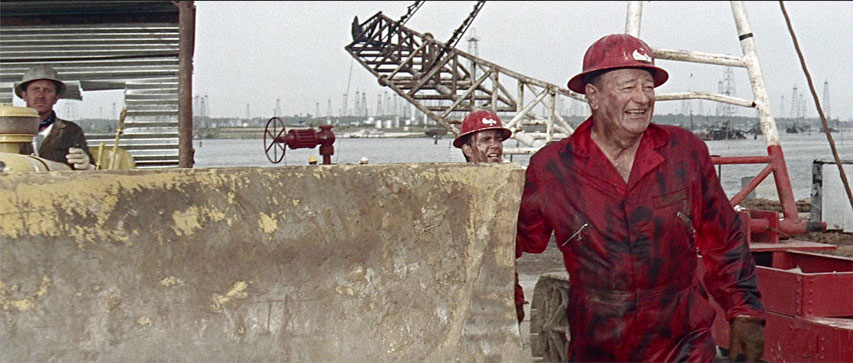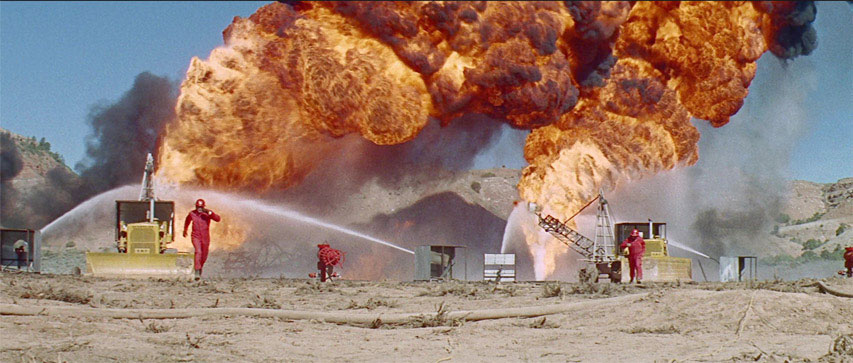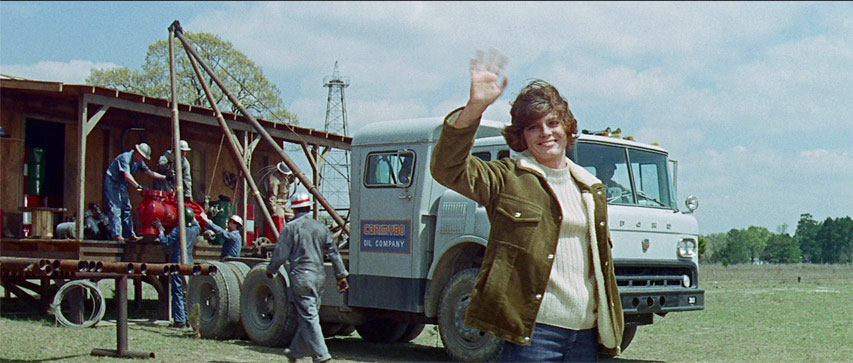| |
“Tomorrow is the most important thing in life. Comes into us at Midnight very clean. It's perfect when it arrives and it puts itself in our hands. It hopes we've learned something from yesterday.” |
| |
John Wayne’s gravestone epitaph |
Despite his enormous popularity and a seriously impressive career, John Wayne was a divisive figure especially when the United States edged into the sixties, a period that promoted higher consciousness raising, a time of a deeply unpopular war and flower power. If John Wayne were alive today, many sensitive souls working for social justice may not even believe such a man walked the Earth. Wayne’s opinions and political stance are both irrelevant to his movies and his acting ability (he always maintained that he didn’t act, he reacted) but in case younger site visitors want to check out this giant of cinema and look him up on Wikipedia, watch out. You may not like what you find. Warning over. Wayne was the quintessential rough and rugged he-man of Hollywood. Ring any alarm bells? He carried his substantial frame with a much imitated swagger and almost every character he played, whether drunk, sober, overbearing or intolerant, there was always a firmly moralistic heart beating in that barrel of a chest. He was a man of his time, a time long since passed. If his masculinity wasn’t exactly toxic in its proper context, I’m sure today it would be a different story.
At the age of 61, well beyond his glory years, he plays Chance Buckman, a close-to-retiring oil firefighter, a specialist in a very dangerous field. Think about that perfect John Wayne character name, one that almost slips into parody. He played a character called ‘Chance’ in Rio Bravo, a man who takes chances. Then you have the male deer also known as a ‘buck’. Can a man be any more manly with a name like Chance Buckman? It’s so John Wayne, so riddled with over the top machismo, it’s practically a Village People spoof. If his rival was called Risk ‘Wolf’ Heman, it couldn’t be sillier. The character is based squarely on the most famous oil firefighter of them all, Red Adair (a name also with some baggage). Buckman is in charge of his own globetrotting company with its own jet. He has a cadre of dependable men with whom he hangs out, all in awe of the big man and is a casualty of a wrecked marriage to a woman who could not stand the emotional angst knowing the high risks her then husband took every time he went to work. We sense that this relationship may be resolved as time goes by. You think?

The film’s structure is fairly predictable. Fires increasing in intensity and risk are dealt with by the team, in between which we have a family saga trying to resolve itself. A smashed light bulb sparks a blaze that engulfs an oil drilling site. As men run away, bodies burning, we have the titles and the wildly manly score by Leonard Rosenman. So we know what our heroes are up against. Successfully putting out the burning oil well, Buckman’s men are returning to a safe space when a member of the press runs towards the group causing a bulldozer to veer to the left crushing Buckman rather unconvincingly with its blade. So Wayne is the wounded solider now until he gets better. In between the action is essentially soap opera. Wayne’s young testosterone-fueled partner in the company, Greg Parker (played by Jim Hutton), is established as a ladies’ man (do they exist anymore?) who uses the oil fires as a seduction technique which is about as twisted as it gets. We know he’s a ladies’ man because he is seen with three different women within 20 minutes before the third becomes the ‘one’. It’s Wayne’s daughter, Tish Buckman (see what I mean about soap opera?) played by pre-Butch Cassidy’s Katharine Ross. I like Ross but her being in this film is like the past being ineffectually prodded by the present and told to lay down its arms. But Hellfighters stays rooted in its own outdated time and I’m far from certain that our 2021 culture can truly forgive it.
Hutton is a good actor but a little miscast as a dynamo of seduction. He co-starred with Wayne in the contentious pro-Vietnam War movie The Green Berets. Wayne obviously gave him the Duke’s seal of approval. Ross is the modern woman who wants to share her new husband’s risks albeit from a greater distance. Wayne reconnects with his ex-wife (surprise) played by Vera Miles, a woman who gives as good as she gets. The one anti-macho argument this film could boast is that Miles is in complete control of her man utilising an icy stare that cowers Wayne but with a masculine wink that undercuts that female power. Hellfighters exists in a man’s world (which as the song goes “wouldn’t be nothing, nothing without a woman or a girl.”) To be fair, the cast is solid but they are all acting in what seems to be another century. The idea that a few years later Butch Cassidy was released seems to cast Hellfighters even further back in time.
On the plus side, when fighting the oil fires, something must be acknowledged here, something more apposite today after hearing about Alec Baldwin’s tragic on set accident in which the director of photography of the film Risk was killed by a bullet from a blank firing prop gun. The actors, stuntmen stand-ins accepted, are really near to real flames. In every one of the oil fire scenes, you can feel the heat. Yes, they are real fires (perhaps not oil fires and sometimes brilliantly convincing miniatures) and yes, sometimes the actors are very close to them and that gives this film a reality that CGI flames could never provide. To the film’s credit, this adds immensely to the effectiveness of these scenes and to that end, the filmmakers should be applauded. Yes, the ‘oil’ is oil bean water. Close ups of oil sprayed actors are unconvincing (oil sticks, water-oil doesn’t) but you brush those trivialities aside.

On the downside, Leonard Rosenman’s score is machismo writ large. Despite his all too obvious command of an orchestra, Rosenman plays to his perceived strengths and often repeats himself. There are string and woodwind sections in the score than sound eerily familiar. His work on Star Trek The Voyage Home and Lord of the Rings (the animated Ralph Bakshi 70’s version) seem to re-quote musical sections. It’s a sort of musical signature. All the best composers do this (they can’t help it) like John Barry whose orchestrations are again eerily similar from movie to movie. There is also a scene in the film that seems completely superfluous. Wayne is welcomed back to his primary and most effective role as firefighter-in-chief and receives a ridiculous welcome from his team, stepping off an aircraft like Christ re-anointed. It’s a little embarrassing. Whether modern sensibilities and audiences can appreciate the movie for what it is rather than what it now seems to have become (an out-dated example of male dominance in a world where women were accessories to men’s heroics) is a moot point. It’s a time capsule of an age when men were real men, women were real women and small furry creatures from Alpha Centauri were real small furry creatures from Alpha Centauri. Thank you Douglas Adams. You are sorely missed.
As a 2.35:1 presentation, the print looks lovely. The colour pops out and contrast levels are right down the middle. There are not many shots with deep blacks (fires out of control are a major co-star remember) and the grain while definitely there, is hardly noticeable. There is some sparkle and dust evident and a lovely 15 frame tramline or hair in the dead centre of frame as a helicopter flies from left to right in the climax (at about 1 hour 48 mins 22 secs or so) but these are small gripes. This is a wide screen Hollywood production, something that has its own nostalgic thrill. Let’s ease up on the pedal of sexual politics. Or perhaps let’s not.
The original 6-track stereo is presented as 5.1 surround audio with an optional choice of stereo audio. The original stereo is beautifully recorded and very faithfully presented. The orchestrations are solid and the sound and dialogue crisp. On a switch to the 5.1, there’s a pleasing power gain on the sound in general although the real ‘feel it in your bones’ low frequency effects weren’t immediately obvious but those fires make a hell of a roar regardless. All the dialogue is front-delivered with the atmospheres and music providing that enveloping feeling.
There are new and improved subtitles for the deaf and hard-of-hearing.
Audio commentary with film historians C Courtney Joyner and Henry Parke (2021)
Joyner and Parke are obviously enthusiastic and very knowledgeable and the screen specific commentary benefits greatly from their interplay. Some nuggets straight off the bat remind us that in the first sequence (that of a fire starting at an oil well) there is a cunningly integrated miniature and to be honest, it didn’t even occur to me. Kudos to special effects head Fred Knoth. In the second scene the invisible matte painting work of the legendary Albert Whitlock still impresses. As he got older, John Wayne (referred to as ‘Duke’ in this commentary) quite rightly insisted that parts reflected his real age. There’s no getting around the fact that the Wayne persona sits over his pictures like a King surveying his realm. As Katharine Ross enters the frame, Joyner and Parke discuss her relationship with the big man and surprisingly politics was not mentioned despite their idealistic mismatch being reported elsewhere. It seemed to be all hugs and cuddles except for some flippant remark she made in an interview about wanting to do better movies than Hellfighters. The two men wax lyrical over Vera Miles, one of Hitchcock’s favourite leading ladies, a relationship that soured once she was set to play the lead Madeline in the movie currently at the very top of the Sight and Sound best movie ever poll, Vertigo. Hitchcock dropped her once she got pregnant. Hmm. Stuntman and director Hal Needham gets a lot of attention but after all, he was quite brilliant. It’s only now that more stuntmen are getting to direct their own action films… Wayne had a skin allergy to standard make-up and costume designer Edith Head (the most famous in her field in her day) had to make sure the clothing de-emphasised the more red his face would look. Cinematographers had to adjust lighting to accommodate Wayne’s problem. Both commentators have a wealth of information about Universal Studios and the aspects of the films that a lot of them share. Whitlock’s matte paintings are pointed out throughout (Joyner and Parke may be a shade ahead timing-wise having noticed a front credit before it came up on screen) and again, I cannot see what they are talking about. John Wayne’s own company is mentioned in regard to how many films he actually produced and not starred in. Expertise of the effects technicians is noted particularly with the five fires occurring at once in the climax. A little late but composer Leonard Rosenman gets a nod (see my musings in the main review). Parke is not keen on Ross’s hair. Universal’s output was changing and Don Siegel was quoted as saying “There is a feeling of Instant coffee the way you handle movies here!” Once Jaws came along, the studio changed with the times. This is a commentary that both celebrates the Hollywood old school and acknowledges its passing.

The BFI Interview with Andrew V McLaglen (1999): archival audio recording of the director in conversation with David Lewin at the National Film Theatre (1 hr, 00’ 59”)
A fascinating interview with so many character moments and revealing snippets about the biggest stars of the era. I had no idea that McLaglen was linked so closely with John Ford. McLaglen worked with big stars and was happy to report that once Kirk Douglas called him ‘Sir’, he knew they were going to get along just fine. The stand out nuggets of information for me were learning that Doris Day had a fondness for Remy Martin (the cognac), and legendary drinker Dean Martin’s confession that “When drinking with Frank (Sinatra naturally), the third one goes in the flowerpot!” There’s a shout out for the lovely William Holden and while working with another two legendary fans of a tipple or sixteen, Richard Burton and Richard Harris, we learn the actors apparently stayed sober for the whole shoot of The Wild Geese. Am waiting for confirmation on that from a friend of mine, John Grover, who was the assembly editor on that film. And finally, imagine, if you will, your neighbour in Hollywood was none other than John Williams the composer. How cool was that?
Andrew V. McLaglen The Director and the Duke (3’ 26”)
This one ended just as I got comfortable. I’m not sure if the McLaglen (Mary) doing the interview is… wait. There’s this thing called Wikipedia… It must be a daughter as none of his four wives was named Mary. For the brevity of the running time, you get some lovely snippets but I would have preferred more. His answer to the question “What qualities did ‘the Duke’ see in you to work with you so often?”, McLaglen’s answer is perfect… “I knew what I was doing.” That’s an epitaph, right there.
Audio Interview with Edward Faulkner (21’ 02”)
C. Courtney Joyner calls Edward Faulkner (the audio is telephone call quality but quite clear) and talks about Faulkner’s relationship with Wayne and how he got the part in The Green Berets. He reminisces about the stuntmen who outnumbered the actors in the oil fire scenes in Hellfighters. He seems very proud of his connection with ‘the Duke’ (Wayne’s nickname). He’s very sprightly and still marvellously enthusiastic at the age of 89. A lovely addition to the disk.

The Rare Breed: Tom Vincent on Andrew V. McLaglen (28’ 21”)
I never made the father/son connection, which now seems obvious, between the John Ford regular Victor McLaglen and the six foot seven inch action director Andrew V. McLaglen with the initial V which stood for his father Victor. Tom Vincent’s cry of “Let’s hear it for the journey men!” is long overdue. McLaglen was always a name on the periphery of my cinema passion having never made a classic but neither had he suffered a bad career. The director was somewhat squeezed between decades when tastes changed alarmingly in Hollywood. Vincent’s presentation is brilliantly researched, simple but heartfelt and I enjoyed it enormously.
Super 8 version: original cut-down home-cinema presentation (7’ 22”)
Before VHS, there was 8mm film! You don’t have too much time to get to grips with the characters but there’s a fair smattering of action still on offer but black and white is not the colour of fire so something’s assuredly lost in this translation.
Theatrical Trailer (2’ 50”)
“How do you put a lid on hell itself?!!!!” Calm down. It’ll all be fine. Wayne was roped in for a few choice sound bites and they’re both as corny as Kansas in August (apologies lyricist Oscar Hammerstein II). Mind you, if it’s fire themed action you’re after then this trailer delivers. And as the penultimate screen text blares at you, NOTHING – EVER – LIKE – IT! I may be inclined to agree.
Image gallery: promotional and publicity material
This consists of 31 black and white production stills, 9 colour (with a little repetition), 4 black and white behind the scenes (Wayne and co-star Katharine Ross on a day when their political disagreements weren’t aired passionately) and 1 colour of both Wayne and Ross. These are followed by the promotional material, 9 colour front of house stills (over 5 screens) and poster artwork and French and Spanish posters and an English one whose artwork is questionable. Wayne looks like he’s been drawn by a someone new to the craft. There are 4 more colour posters on offer.

Desert Inferno (1962) (1’ 39”)
What a tease! The newsreel voice, one I’ve heard many times with that clipped authoritative delivery leads us all on with graphics to explain how a desert gas fire will be extinguished by the modest and legendary ‘Red’ Adair and his team and then we fade to black. Now come on newsreels… Let’s see the damn explosion at the very least.
News Report from Ekofisk Oil Field (1977) (1’ 23”)
Mr. Adair gives a press conference on fixing an offshore oil rig in Norway because someone had installed the blow out machinery upside down. Say what? It’s not the right industry to make screw ups like that.
Limited edition exclusive booklet with a new essay by Andrew Nette, archival articles on the film and the events that inspired it, an overview of critical responses, and film credits
The booklet wasn’t available for review at time of writing.
Hellfighters is an old school adventure yarn, very well made if a little on the talky side. It’s sold on its daring firefighting sequences and they pay off handsomely with seamless miniature work and very realistic ‘oil’ fires. Because of the age of the film and the nature of a John Wayne picture, there’s a great deal of respect for ‘the Duke’ that reminds me of an unofficial gentlemen’s club. To really enjoy it you have to see it as a product of its time. I remember loving it as a child, a boys’ own adventure. Perhaps 2021 won’t be as kind but it’s still worth a watch even if it’s to understand historical Hollywood a little more and an era that a large mechanical shark all but buried in its wake.
|